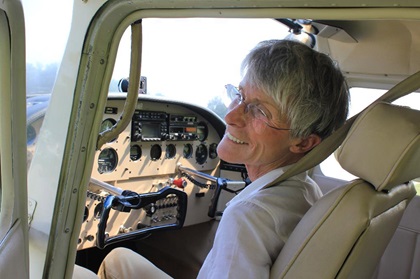Aviation writer Martha Lunken's pilot certificates revoked
'Knew it was wrong' to fly under Ohio bridge
Lunken told AOPA on April 21 that “the FAA deserved to discipline me—and severely” for flying under the 239-foot-tall Jeremiah Morrow Bridge, which carries Interstate 71 over the Little Miami River in southwestern Ohio and has main spans of 440 feet.
Lunken, who flies from a public airport that bears her last name, said that she was “out boring holes in the sky in my [Cessna] 180 and made a couple of landings” at the Lumberton grass strip northeast of Cincinnati in March 2020. She was on her way home to Cincinnati Municipal Airport/Lunken Field when “I looked over my shoulder and saw the bridge and I said out loud, ‘God, before I get too old, I have to fly under that bridge one time.’”
Lunken said that “it provided no danger to anyone, but of course I knew it was illegal. But I did it anyway.”
A six-year, $88 million construction project recently shored up the heavily traveled interstate bridge.
AOPA Legal Services Plan attorney Ian Arendt recently wrote about FAR 91.119, the regulation that mandates pilots maintain a safe distance from any person, place, or structure, in “congested” or “uncongested areas.”
“She wouldn’t be the first person I’ve talked to that had the thought to fly under a bridge,” Arendt said.
In a congested area, pilots must fly “1,000 feet above the highest obstacle within a horizontal radius of 2,000 feet of the aircraft” other than when taking off or landing. In an “other than congested area” the clearances are less, but Arendt reminded pilots that FAA regulations say an aircraft may not be operated at less than 500 feet above the surface; and that “over ‘open water’ or a ’sparsely populated area,’ an aircraft may not be operated closer than 500 feet from any person, vessel, vehicle, or structure.” Moreover, he reiterated that pilots must “always maintain a sufficient altitude to avoid undue hazard to persons or property on the surface in the event of an emergency landing.”
The FAA describes careless or reckless operation in FAR 91.13. “If a pilot is doing something potentially hazardous like flying under an active bridge, the FAA may allege that you are endangering people driving on the bridge, or people under the bridge doing recreational activities. The FAA also may allege you are in danger of damaging the bridge itself,” Arendt said. “Potential endangerment of persons or property is sufficient to invoke a certificate action.”
The area under the bridge attracts the public to hiking and biking trails, and the river and nearby streams are popular fishing locations. Lunken said she is familiar with the area because she participates in outdoor activities there.

The Cessna 180’s transponder intermittently stopped squawking a code to Cincinnati approach during the flight, and Lunken, a longtime FAA safety official, said she believes that landings earlier in the day at the Lumberton grass strip may have shaken her transponder loose. An Ohio Department of Transportation surveillance camera on the bridge captured an image of Lunken’s aircraft flying under it. Lunken didn’t think much else about it until the FAA contacted her weeks later.
By then she was in touch with an aviation lawyer but didn’t hear anything further “whatsoever” for many months. “I know that after about six months that’s sort of a drop-dead date from the FAA regarding suspensions,” she said. “Every day, I’d look in the mailbox and think, ‘Is it here?’ In March [2021], a year and a week after the event, there’s a big box on my porch with radar tracks,” other evidence, and “an FAA letter with an emergency revocation of all my pilot certificates” inside.
“As soon as Martha knew about it, she let us know,” said Flying magazine Editor-in-Chief Julie Boatman. “She’s been up front with us about it since day one.” The magazine posted a note on its Facebook site that acknowledged Lunken made a “mistake in judgment” and will “be working towards the return of her flying status in the future.”
“It makes you feel like you’re nothing,” Lunken said. “I can’t describe to you the hole inside me. It’s my life.”




